MINGEI: Theory, Aesthetics, Spirit

“Although the time will come when the meaning of the word mingei will be clarified, it does not seem possible while this generally used term continues to take on even more meanings. The age when the meaning of mingei was readily understood has passed.”
Okakura Kichiemon, “Mingei”
(“Nihon no Bijutsu” series,) 1973.
The term “mingei” was coined by the founder of the Japan Folk Craft Movement, Yanagi Soetsu (1889-1961) in the 1920’s, and was popularized around the world by Yanagi and other prominent first-generation Movement members such as the potters Hamada Shoji, Bernard Leach, and Kawai Kanjiro. It is generally translated into English as “Folk Art”, or “Folk Craft.” And although Mingei Theory was a radical challenge to conventional ideas of art and beauty, and went on to influence many studio arts and crafts worldwide in the 20th century; the study of mingei has remained little more than a footnote in the study of art history, if mentioned at all.
On Saturday, March 4th, Tatsuo Tomeoka of WaSabiDou Antiques & Folk Crafts will lead a discussion entitled “MINGEI: Theory, Aesthetics, Spirit” at Shoreline Community College. Also, mingei and contemporary mingei-inspired crafts will be on display. WaSabiDou will also hold an Open House in conjunction with this talk in the weeks prior to and after March 4th, details below.
In an effort to clarify the definition of “mingei” in a modern context, Tomeoka will aim to cover some of the basics of Yanagi’s Mingei Theory, including the ideals of mingei aesthetics and “standards of beauty.” Tradition, and the Buddhist philosophy of “tariki” (Other Power) were central to Mingei Theory. Yanagi felt that the handmade work of anonymous craftspeople contained qualities of “true beauty,” in accordance to Buddhist principles applied to his theories. Although many of these concepts seem to contradict modern views of creativity and artistic freedom, which are so important to the studio artists today who have all but replaced the anonymous craftspeople of yesterday, Yanagi made viable arguments as to their universality and timelessness. In this regard, “Mingei Spirit”; the influence of mingei objects, traditions, and thought on contemporary crafts, will also be discussed to gain insight to the future of mingei, in terms of its role for the individual artist and society at large.
On display will be antique mingei objects, such as ceramics and folk tools; vintage pottery from the town of Mashiko (which gained worldwide attention as a center of “folk-style” pottery due to the presence of Hamada Shoji), representing the 20th century transformation of folk crafts into studio arts; and contemporary works in ceramics, textiles, and wood by Japanese & local artisans with backgrounds connected to strong craft traditions, and who continue to be inspired by the “Mingei Spirit.”
“MINGEI: Theory, Aesthetics, Spirit” will be at:
Shoreline Community College, Art Building, Room 2059, 16101 Greenwood Ave. N., Shoreline, WA 98122.
Time: 1pm preview, 2-4pm lecture/discussion.
During the preview & intermission, Okinawan Folk Music will be played by Mako (Masae Willet) on the Okinawan instrument, the sanshin.
In conjunction with the lecture event, WaSabiDou Antiques & Folk Crafts will be holding an open house exhibit & sale of antique through contemporary crafts from Japan & SE Asia. Sale dates are 10am-6pm on Feb 24, 25, 26, March 3, 5, 10, 11, 12, 17, 18, 19
and by appointment.
Location: 127 NW 136th St. Seattle, 98177. Full further information, please contact
Tatsuo Tomeoka at tatsuo@mingei-wasabidou.com or tel: 206-660-4189.
A partial catalog listing of sale items can also be found at the WaSabiDou website:
www.mingei-wasabidou.com . On-line and pre-event sales welcomed!
Driving Directions from I-5 north or south-bound:
-Take the 145th street exit, right at the Seattle City limits. Go west on 145th towards Puget Sound, past the major intersection of Aurora Avenue.
=For Shoreline College, turn right on Greenwood Avenue, and immediately get into the left lane to proceed straight on Greenwood. You'll see the College in just a few minutes. The Art Building is at the north end of the campus. A campus map is on-line at www.shoreline.edu/collegemaps.html .
=For the Open House Sale at Tatsuo's, continue straight on 145th past Greenwood about 1 minute to the end of the road. The Seattle Golf Club will be on your right. The end is 3rd Avenue NW. Turn left here and go south just a minute to NW 136th Street. Turn left on NW 136th, and #127 is the fifth house on the right. Go through the carport around to the back of the house to find the showroom entrance.
Some examples of Japanese mingei objects of the past:
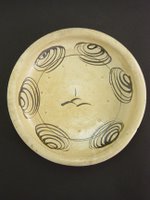 "Umanome" (Horse Eye) platter from Mashiko, ca. 1900. This pattern was frequently used by the Seto kilns in central Japan. Patterns, and often the potters themselves, migrated to other regions in the later Edo period. The horse eye pattern was used in places like Mashiko and Kasama. The famous "sansui" (landscape) pattern of the Mashiko teapot pictured above actually comes from Shigaraki.
"Umanome" (Horse Eye) platter from Mashiko, ca. 1900. This pattern was frequently used by the Seto kilns in central Japan. Patterns, and often the potters themselves, migrated to other regions in the later Edo period. The horse eye pattern was used in places like Mashiko and Kasama. The famous "sansui" (landscape) pattern of the Mashiko teapot pictured above actually comes from Shigaraki.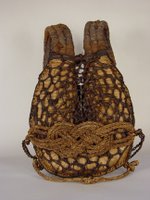 "Bandori" is a pad used for carrying heavy loads on the back. This particular early 20th century example, from the Yamagata area of NE Japan, shows a superb use of mountain grape vine braided over the straw pad. The shoulder straps are woven from old cloth scraps.
"Bandori" is a pad used for carrying heavy loads on the back. This particular early 20th century example, from the Yamagata area of NE Japan, shows a superb use of mountain grape vine braided over the straw pad. The shoulder straps are woven from old cloth scraps.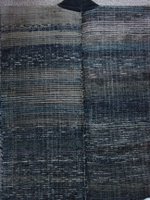 This "sakiori," or rag-weave, vest is a fine example of folk craft textiles. Made of torn fabric remnants, sakiori shows how the ingenuity of necessity among rural farmers creates a simple beauty that typifies mingei.
This "sakiori," or rag-weave, vest is a fine example of folk craft textiles. Made of torn fabric remnants, sakiori shows how the ingenuity of necessity among rural farmers creates a simple beauty that typifies mingei.Mingei Theory has no national or cultural boundaries.
It applies to all cultures with craft traditions.
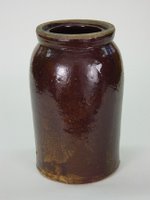 Late 19th century American canning jar.
Late 19th century American canning jar. Si Srichanalai Bowl, underglaze iron decoration of flower.
Si Srichanalai Bowl, underglaze iron decoration of flower.Ca. 15th-16th century, Central Thailand.
 Jarlet, underglaze cobalt blue decoration.
Jarlet, underglaze cobalt blue decoration.Ca. 18th century, Vietnam.
The 20th century saw the transformation of craft makers from artisan to studio artist. Some came from generations of craftmen & women, but some also came from art schools and independent backgrounds. Some featured mid-20th century items with "Mingei Spirit" include:

Yunomi (Tea Cup) attributed to Shimaoka Tatsuzo
(National Living Treasure); Mashiko, ca. 1960.

Hanga (Woodblock Print) by Tomimoto Kenkichi
(National Living Treasure); Kyoto, ca. 1955.

Detail of kasuri (ikat) Kimono from Kumejima, Okinawa, ca. 1960.
Kumejima kasuri was recently declared a National Craft Treaure.
Mingei aesthetics and craft traditions continue to inspire an influence contemporary artists. Here are some local examples from the Pacific NW.
 Evert Sodergren has been called the Dean of NW furniture craftsmen. He is a 4th-generation craftsman whose work is included in the Smithsonian's Renwick Gallery of American Craft.
Evert Sodergren has been called the Dean of NW furniture craftsmen. He is a 4th-generation craftsman whose work is included in the Smithsonian's Renwick Gallery of American Craft.This tansu chest of eucalyptus wood shows the simple lines & quiet beauty of antique tansu from Japan that have inspired Evert for years, without hiding the aesthetics of his Swedish heritage.
Kikuko Dewa is a 5th-generation textile artist originally from Kyoto's Nishijin district, long famous for its weaving and dyeing of fine textiles.
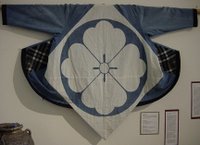 Her great uncle, Kitagawa Heirou, was designated a National Living Treasure twice for work in textiles. Although the aristocratic items produced at Nishijin are not usually considered mingei, Kikuko has developed a love of using recycled materials she finds in antique shops in Japan and the US, often creating items from folk crafts, thus giving them new life as contemporary fabric arts. This "hanten" jacket is made from an old banner bearing a family crest and a bed covering cloth or "futonji" (both indigo-dyed), that has later been reinforced with "sashiko" quilting.
Her great uncle, Kitagawa Heirou, was designated a National Living Treasure twice for work in textiles. Although the aristocratic items produced at Nishijin are not usually considered mingei, Kikuko has developed a love of using recycled materials she finds in antique shops in Japan and the US, often creating items from folk crafts, thus giving them new life as contemporary fabric arts. This "hanten" jacket is made from an old banner bearing a family crest and a bed covering cloth or "futonji" (both indigo-dyed), that has later been reinforced with "sashiko" quilting.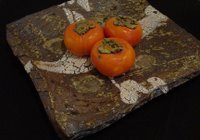 George Gledhill is a potter in Payette, Idaho. His Peace Corps experience working with potters in Bolivia taught him much about working completely from scratch (digging clay, making bricks to build kilns, gathering glazing materials, etc.) and working with nature in the creative and technical processes of potting. This wood-fired square plate is an example of George's work. Several of George's pots, including many wares for Tea Ceremony, will be available at the Open House Sale.
George Gledhill is a potter in Payette, Idaho. His Peace Corps experience working with potters in Bolivia taught him much about working completely from scratch (digging clay, making bricks to build kilns, gathering glazing materials, etc.) and working with nature in the creative and technical processes of potting. This wood-fired square plate is an example of George's work. Several of George's pots, including many wares for Tea Ceremony, will be available at the Open House Sale.Please check for occasional updates to this web log and the WaSabiDou web site.
